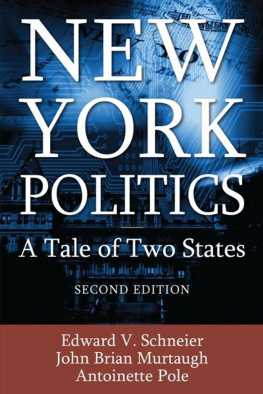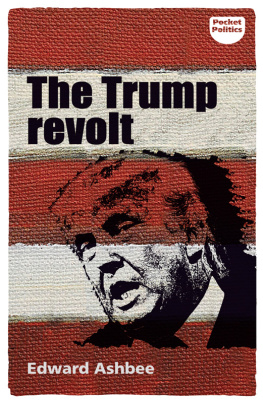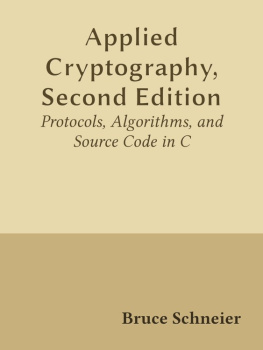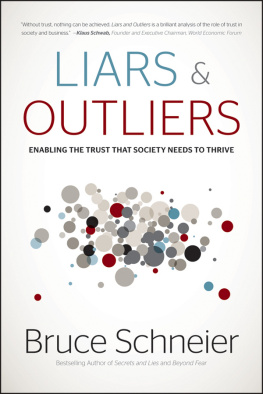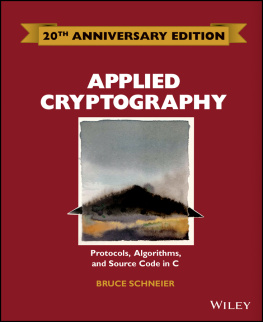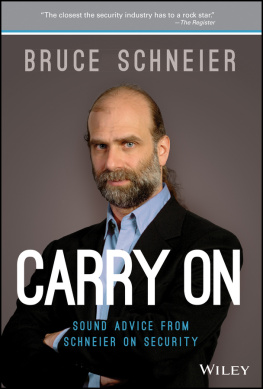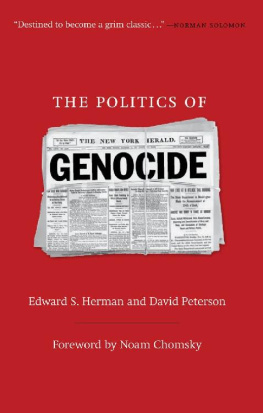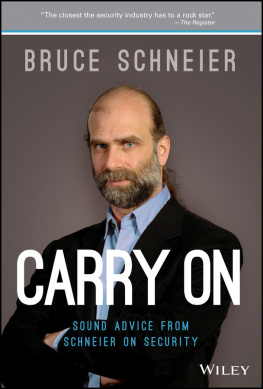First published 2001 by M.E. Sharpe. Inc
Published 2019 by Routledge
2 Park Square, Milton Park, Abingdon, Oxon OX14 4RN
52 Vanderbilt Avenue, New York, NY 10017
Routledge is an imprint of the Taylor & Francis Group, an informa business
Copyright 2011 Taylor & Francis
All rights reserved. No part of this book may be reprinted or reproduced or utilised in any form or by any electronic, mechanical, or other means, now known or hereafter invented, including photocopying and recording, or in any information storage or retrieval system, without permission in writing from the publishers.
Notice:
Product or corporate names may be trademarks or registered trademarks, and are used only for identification and explanation without intent to infringe.
Library of Congress Cataloging-In-Publication Data
Schneier, Edward V.
New York politics: a tale of two states/Edward Schneier and John Brian Murtaugh.
p. cm.
Includes index.
ISBN 0-7656-0064-1 (alk. paper) ISBN 0-7656-0065-X (pbk. : alk. paper)
1. New York (State)Politics and government. I. Murtaugh, Brian, 1937II. Title.
JK3416 .S25 2001
320.9747dc21
00-053158
ISBN 13: 978-0-76560-064-6 (hbk)
A Tale of Two States
The famous opening lines of Charles Dickenss Tale of Two Cities describe the people of France as living, on the eve of Revolution, in both the best of times and the worst of times. Much the same could be said, on the cusp of the twenty-first century, about the people of New York. While it ranks fourth among the fifty states in per capita personal income, New York consistently exceeds the national average in the percentage of its citizens below the poverty line, and ranks eighth in the proportion of its residents on public assistance. It has 225 four-year colleges, far more than any other state, but also ranks second in prisons and spends more state money on prisoners than on college students. Nearly 10 percent of its citizens have advanced degrees, but 25 percent are high school dropouts. It is number one in health spending per family, but ranks eleventh in percentage of its population (20.8 percent) described as medically under-serviced. While it is often depicted as a state low on traditional family values, it is tied for the fourth lowest divorce rate in the nation.
New York, as Sinclair Lewis once said, is not America, to which the residents of many other states would add a fervent Amen, Yet there is a simultaneous sense in which the Empire State is widely perceived as the quintessence, if not of the United States as it is, then of what it is about to become. From the highbrow humor of the Algonquin Round Table to the broader strokes of a David Letterman top ten list; from the Metropolitan Opera to the Broadway stage; from Madison Avenue to the Garment Center; and from the art galleries of SoHo to the publishing houses of midtown Manhattan, it has enduredfor better or worseas the cultural capital of the New World. Kodak, Xerox, and IBM made New York the early leader in the development of high technology industries. Wall Street remains the financial capital of the nation and its global economy. At the same time, upstate cities have remained virtually detached from the economic boom of the 1990s, farms are disappearing at an increasing rate, and the states credit rating is among the nations very worst.
New Yorks political history is studded with innovations: Al Smiths initiatives in passing minimum wage and worker safety laws anticipated the New Deal by twenty years; Robert Moses created an empire of parks and highways, and a governing structure to go with them, that became prototypes for all fifty states; and the state was a pioneer in creating the nations first equal opportunity commissions. It has received its share of dubious achievement awards as well. The financial collapse of New York City in the 1970s, and the subsequent bailout of the city by the federal government, continues to serve as a symbol of urban decline. Although its state taxes are comparatively low, its combined state-local tax burden is among the nations highest. The New York congressional delegation has distinguished itself neither by providing its share of national leaders nor for bringing barrels of federal dollars into the state. And for all of their putative sophistication, New Yorkers probably know less about their own states government than do the residents of any other state. Voter turnout is shockingly low, and the states election laws are Byzantine at best. The states progressive policies are increasingly regarded less as prototypes of what ought to be than as cautions against the paving stones of good intentions. In the words of The Almanac of American Politics, The noble aim of creating a public sector which would guarantee cheap rents, topnotch public schools and colleges, public hospitals, instead guarantees that none of these will be available. The attempt to create a fail-safe society had produced a sure-to-fail government.
This then, is a tale of two states: a state that is at once the richest and the poorest, sophisticated yet politically detached, liberal in intents yet slow to deliver. Our purpose in this book is to explain the politics of this dualism, giving particular attention to the changes in recent years that have challenged if not overthrown the Empire States tradition of political liberalism. Is New York governed as badly as many of its citizens believe? How does the political system work? From our perspectives in the worlds of academic political science on one hand, and of practical politics on the other, what we have tried to write is a citizens textbook, a book that at once tries to make sense of what is arguably the nations most complicated and secretive political system.
Were New York a corporation, the states finances would rank it eighth in Fortune magazines ranking of the 500 largest corporations. Were it a country, it would be among the worlds ten largest. Because it is part of the federal union of the United States of America, it neither can nor should be treated as a significant sovereign nation; but it is important, far more important politically and economically than many national governments that have received considerably attention both from the media and from academics. In part because New Yorkers tend to focus on a more national and global scale, and in partmore parochiallybecause the state does not require its high school or college students to take a course in New York government, there are almost no books available on the system. Our hope is to fill that gap.
Few governments have ever satisfied all of their citizens or done all that they could to satisfy their needs. Because of its enormous wealth and proud history, there is an expectation that New York is better positioned than most states effectively and efficiently to deliver the goods. The first half of this book is devoted to an analysis of that issue. What we hope to show is that despite its economic and cultural advantages, New York is an extraordinarily difficult state to govern. The bond of a common political culture, of the kind of basic underlying consensus on fundamental values that makes political discourse productive, is at best minimally in evidence in New York. The cleavages that divide the state ethnically, regionally, and economically, as we argue in , are sharper than in other states, less susceptible to compromise, andin the final analysisinimical to good government.

